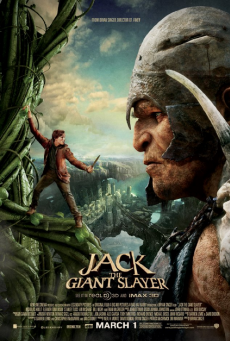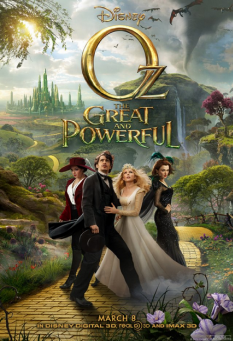By Michael Scoular (The Cascade) – Email
Print Edition: March 13, 2013
 The studio system heights of three-credit screenplays and effects studios by the handful bring with them a question of how there ever happens to be a movie with a distinctive edge, a movie with an individuality among the smoothness of adjustments fitted to focus-tested anticipation.
The studio system heights of three-credit screenplays and effects studios by the handful bring with them a question of how there ever happens to be a movie with a distinctive edge, a movie with an individuality among the smoothness of adjustments fitted to focus-tested anticipation.
Bryan Singer (Jack the Giant Slayer) and Sam Raimi (Oz The Great and Powerful) made some (or in Singer’s case, all) of their best movies in what has become the most over-determined and predictably “entertaining” genre – the straightforward superheroes, up against evil, identity and fear. Compromises and conventions are everywhere, but Singer showed a keenness for navigating iconography, a patience with character that made the core of his X2: X-Men United and Superman Returns more about statements against rule, questioning the passing of generations, when they weren’t fulfilling the plane-saving, claw-baring requirements of entering a narrative midway. With Raimi, almost everything is a joke or a horror show, and the Spider-Man series was a space for these sides to stand in opposition, mingle, come out in slapstick, visions and dances. Together, this was the base of the best of the genre, something alive (something even more noticeable with each year of new numbers and team members) found in the dead-for-profit of action figure advertisement.
 But that is the past. There are questions of authorship in a studio system to be made, but the real impression from seeing these two directors’ latest movies is how little it takes for a thought-to-be individual touch to be assimilated, and how little they count for when in the service of something so completely contemptible.
But that is the past. There are questions of authorship in a studio system to be made, but the real impression from seeing these two directors’ latest movies is how little it takes for a thought-to-be individual touch to be assimilated, and how little they count for when in the service of something so completely contemptible.
Jack the Giant Slayer and Oz the Great and Powerful are two movies that occupy the same space. Both carry barely attached copied manuscripts of tired stories with the names changed and the old values continued – the reluctant hero overcomes schemes and danger to rescue the princess and the reluctant hero overcomes schemes and danger to save the people (and the princess). In Jack the Giant Slayer, which lacks a forbearer of quality like The Wizard of Oz, pains are taken to impress a brand where there isn’t one – Jack is asked what his name is, what his qualities are, and what his name is in hope he’ll make a heroic impression. Whatever they call themselves, both are products of synergy – taking a part of that thing you liked that one time and a part of new technology and names to create a sort-of spectacular movie that’s in between completely expected and completely pointless.
The nadir of this might be the 3D re-release, a coincidental trailer example of Jurassic Park 3D playing before Jack the Giant Slayer as reminder. Actually, the word, the imperative word in trailer text is “Remember,” which is actually the opposite of what seeing Jurassic Park 3D would do. Remembering is fallible, flexible and completely free, which is nothing a studio or studio release would want anything to do with. The solution then is what Jack and Oz are all about: working against what we remember, and trying to be what we will newly remember – this is the telling of the tale for our time, with more ugly realism or more magical objects thrown through the screen.
Oz the Great and Powerful is the less unbearable of the two because, even if there’s something too-slick about the digital repetition of techniques Raimi roughly, ridiculously displayed in The Evil Dead, those familiarities are as good as it gets here. Black and white long takes of cascading physical comedy, a playful precipice in animated silhouette, the technique of material magic: this is what Raimi brings, though a waste that it was brought here. Whatever Singer ever brought, if Jack the Giant Slayer is any indication, that has and can stop. Lit to highlight nothing and point out the green screen of everything, digitally dated (the movie was delayed for a year, and it shows), and full of bereft creature design with ugly motion capture to fit, the best that can be said for it is it skips the double-speak lie-allowance of Oz and is plainly worthless in total.
Both movies open with fictions – the stories told to children that lead to ideas. And the ideas of Jack the Giant Slayer and Oz the Great and Powerful are sold in their titles and the names above them. Nicholas Hoult (Jack) has the perpetual look of being half-frightened, talking out of the side of his mouth like it’s being operated by someone else, and James Franco (Oz) plays himself playing himself as seen in comedy skits and awful award ceremonies. Neither really stands out, because aside from some typical greatness from Rachel Weisz, the performances in all cases fall into a place where jokey innocence is the target, though their respective roles run on irony and lies. So they’re not getting by on screen presence. But they’re getting into positions of power.
It isn’t fair to call these plots retrograde, because if anything they are damaged by the present – additions and removals come as monarchy is now what defines both stories, and female roles vanish (even the mother in Jack and the Beanstalk). There’s nitpicking, and then there’s the obvious detail that—and these are films from the 1930s—Maid Marian in The Adventures of Robin Hood and Dorothy in The Wizard of Oz (the movies these variants aspire to be) are more active, progressive and intelligent characters than those in two popular movies from 2013. Just about everything about Jack the Giant Slayer is unintelligible – the warlike, grimy atmosphere sliding into mock-fantasy (with The Lord of the Rings-culled fanfare), suggesting incongruous collaborative efforts. But one thing remains consistent: Princess Isabella asks what Jack’s name is, learning to be able to scream it as she becomes the damsel in helpless distress she was destined to be.
The women of Oz (Weisz, Michelle Williams, Mila Kunis) are notable mainly for their complete inability to do anything before a rightful ruler arrives on the scene to tell or suggest them to. There’s a conflict on the table, but nothing happens until the one “who’s going to fix everything” shows up. And it turns out the politics of warfare of the kingdom of Oz are the vindictive, petty scorned lover acts of easily-fooled and willingly-deceived witches. Everything revolves around the one who holds the throne, even from beyond the grave – the seething line during climatic violence? “You took what mattered most to me – my father.” The everyone-encouraging finale congratulation? “Your father would have been more than proud.” It’s not as if there’s anything to be gained when clueless screenwriters put pseudo-proto-feminism in material (Snow White and the Huntsman), the current situation’s just terrible all around, at best laughable and worst the propagation of careless bullshit, tautologies of male dominance.


